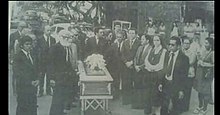Salarrué
This article needs additional citations for verification. (June 2021) |
You can help expand this article with text translated from the corresponding article in Spanish. (April 2020) Click [show] for important translation instructions.
|
Salvador Efraín Salazar Arrué (Salarrué) | |
|---|---|
Sonsonate, El Salvador | |
| Died | November 27, 1975 (aged 76) Planes de Renderos, El Salvador |
| Occupation | Author, editor, painter, diplomat |
| Spouse | Zélie Lardé |
Luis Salvador Efraín Salazar Arrué (October 22, 1899 – November 27, 1975), known as Salarrué (a derivation of his surnames), was a Salvadorian writer, poet, and painter.[1]


Born in
However, few readers understand that the stories in Cuentos de Barro were an ingenious literary feat of Salarrué. By disguising through a subtle use of a non-standard, highly inventive language and style, he was able to recall to readers a bloody massacre carried out by the Salvadoran dictator-president, General
Salarrué lived in the United States from 1947 to 1951 while representing his country in diplomatic posts. He died in Los Planes de Renderos, near San Salvador, and is buried in the Cementerio de los Ilustres ("Cemetery of Distinguished Citizens").
Biography
Childhood and youth
In the 19th century Alejandro Arrué Jimenez (an educator from Basque Country who had worked in various Latin American countries) married Lucía Gomez, native of Sensuntepeque, El Salvador. The marriage engendered many children, Luz and María Teresa among them. They each had literary vocations, but it was Luz, after Miranda, when the family resided in El Salvador, who attained inclusion by the journalist Román Mayorga Rivas in the anthology of poetry "Guirnalda Salvadoreña."
Meanwhile, María Teresa married Joaquín Salazar Angulo, a budding musician from an honorable family. However, for various reasons, the relationship did not prosper which obligated the young mother to provide for her children, Joaquín and Luis Salvador Efraín, alone. The latter was born on a family estate situated in the El Mojón district that would become, in part, the urban zone for the municipality of Sonzacate, in Sonsonate. In the following years, the Salazar family lived in financial hardship even though they received help from close family members since their respected ancestry favored them.
The childhood of Luis Salvador transpired surrounded by the natural tropical splendor of Sonsonate. Although timid and distant with regards to rough and tumble games, he was set apart for his ability to invent stories. When he was eight his mother's financial difficulty forced her to move; for this reason young Luis alternated between his home in San Salvador and Santa Tecla where he lived in the same residence as his cousins Núñez Arrué, of whom one was Toño Salazar, later a renowned cartoonist. For their sustenance Luis's mother worked as a seamstress and acquired her own dress-making academy. Toño gave a description of his cousin in those years:
"Luis Salvador attended elementary in the pedigreed institute Liceo Salvadoreño. He attended high school in the Instituto Nacional de Varones and later in the Academia de Comercio, where he did not finish his studies, yet he always had good grades."
His artistic vocation was already manifest at the age of 11 when one of his compositions was published in the Diario de El Salvador (Newspaper of El Salvador) by Román Mayorga Rivas. The achievement was not luck given that he must have associated with local intellectuals that frequented the house of the family Núñez Arrué .
Works
- El Cristo Negro (The Black Christ) (1926)
- El Señor de la Burbuja (The Lord of The Bubble) (1927)
- O Yarkandal (1929)
- Remotando el Uluán (Remoting the Uluan) (1932)
- Cuentos de Barro (Clay Stories) (1934)
- Conjeturas en la Penumbra (Conjectures in the twilight) (1934)
- Eso y Más (That and More) (1940)
- Cuentos de Cipotes (Children Stories) (1945).
- Trasmallo (1954)
- La Espada y Otras Narraciones (The Sword and Other Narrations) (1960)
- Vilanos (1969)
- El Libro Desnudo (The Naked Book) (1969)
- Ingrimo (1969)
- La Sombra y Otros Motivos Literiarios (The Shadow and other Literary Motifs) (1969)
- La Sed de Sling Bader (Sling Bader's Thirst) (1971)
- Catleya Luna (1974)
- Mundo Nomasito (Poesía -1975)
References
- ^ "¡Feliz cumpleaños, Salarrué! Recuerdan al artista con videos en Facebook". Noticias de El Salvador - La Prensa Gráfica | Informate con la verdad (in European Spanish). Retrieved 2020-04-17.
External links
A partial translation of Cuentos de Barro/Tales of Clay by Salarrué, as accomplished by Nelson Lòpez, is available in a PDF format:
- http://www.udb.edu.sv/editorial/pdf/coleccioninvestigacion/seriebicentenario/cuentosdebarro.pdf[permanent dead link]
And a review or "prologo" in Spanish of that book of English translations by Nelson López is published in Carátula, together with the comparison of the Spanish and English of the story "La botija" / "The Botija" or "jug of gold," in an excellent presentation by Dr. Rafael Lara Martínez in Caratula: Revista Cultural Centramericana:
